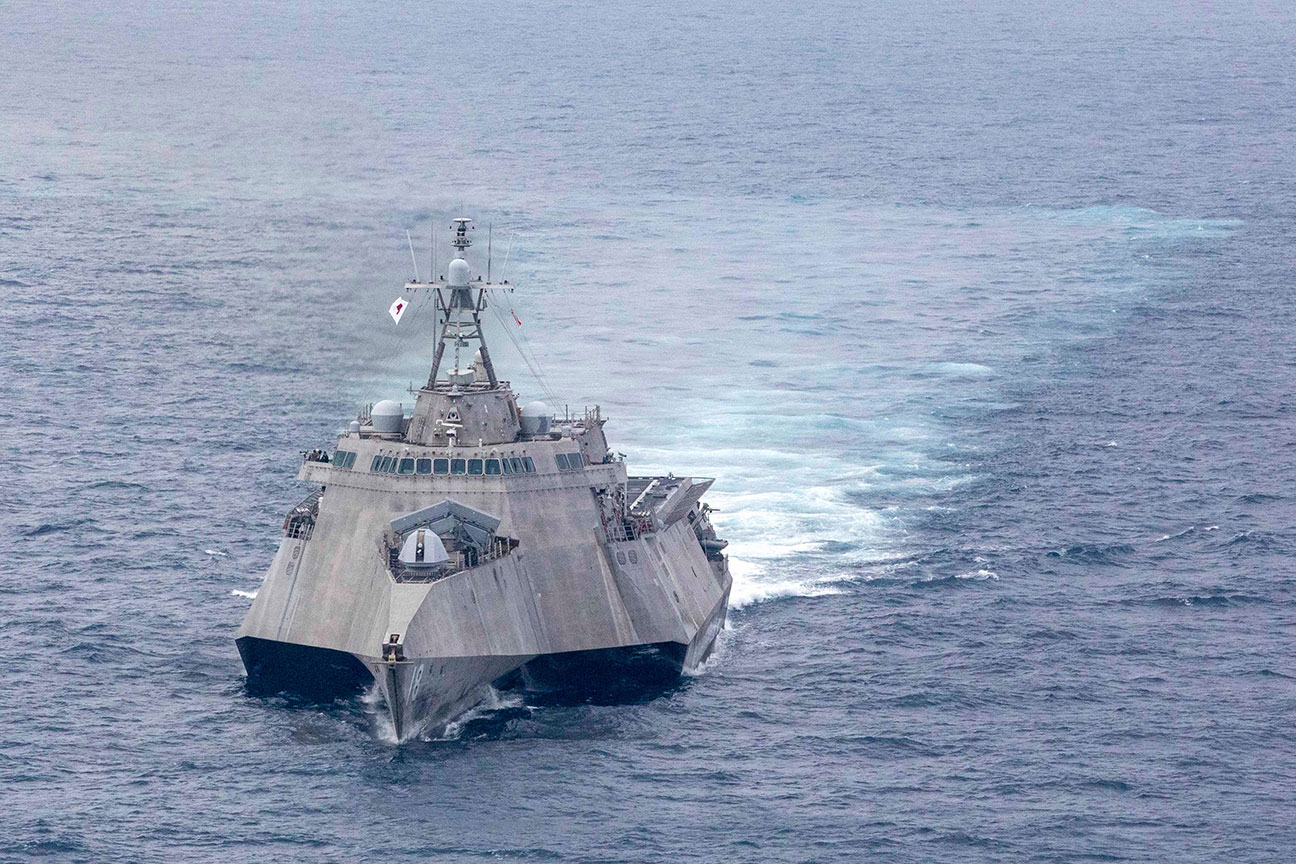An MH-60S Seahawk assigned to the “Blackjacks” of Helicopter Sea Combat Squadron 21 departs from the Independence-variant littoral combat ship USS Charleston in the Strait of Malacca on March 1, 2023. PETTY OFFICER 2ND CLASS DANIEL SERIANNI/U.S. NAVY
THE WATCH STAFF
The Independence-variant littoral combat ship (LCS) USS Charleston left its home port of Naval Base San Diego on May 20 to support the nation’s southern border operations, led by United States Northern Command (USNORTHCOM). The Charleston is replacing the San Diego-based guided-missile destroyer USS Stockdale, which was dispatched to the region in April.
Like the Stockdale, the Charleston embarked with a U.S. Coast Guard Law Enforcement Detachment (LEDET), which brings expertise in maritime interdiction. The LEDET can assist in a range of missions, like countering illegal activities such as drug running and supporting humanitarian efforts and homeland security operations.
“The Charleston’s departure reinforces the Navy’s role in the Department of Defense’s coordinated effort in response to Presidential executive orders and directives,” a Navy news release said. “The Charleston’s sea-going capacity contributes to USNORTHCOM’s ability to protect the United States’ territorial integrity, sovereignty, and security, through a coordinated, multi-domain strategy.”
Each LCS, designed for near-shore operations, is fast, can house two SH-60 or MH-60 Seahawk helicopters, and is packed with air- and surface-search radar. That helps the crew catch drug smugglers, who usually use fast boats or low-profile vessels and sometimes rudimentary submersibles. The LCS also carries missiles. The LCS is “almost perfectly made” for operations against drug smugglers, said Brian Persons, a senior management scientist with the Rand Corp. and former executive director of Naval Sea Systems Command and deputy chief of naval operations for warfare systems.

The Charleston is the fourth Navy ship and the first LCS that the Pentagon has announced is helping with operations at the border. The Stockdale replaced the San Diego-based guided-missile destroyer USS Spruance, which helped with the border mission for several weeks starting in mid-March. The guided-missile destroyer USS Gravely, based in Norfolk, Virginia, deployed about the same time to support the mission.
As the Defense Department’s lead for implementing border-related executive orders, USNORTHCOM continues to augment Department of Homeland Security capabilities. More than 10,000 troops — including active-duty Soldiers, Marines and National Guardsmen — have been deployed to fulfill the border mission.
The Pentagon also has deployed 20-ton armored Stryker combat vehicles and a helicopter battalion, with “UH-60 Black Hawks for command and medical evacuation, and CH-47 Chinooks for heavy lift,” a Pentagon statement said March 1. The Stryker vehicles are lightly armored, eight-wheeled attack platforms that can carry up to 11 Soldiers and usually are equipped with a machine gun or grenade launcher. They have been used in combat in Afghanistan and Iraq. After news of the Stryker deployment, Defense Secretary Pete Hegseth said in a post on X that the administration is “dead serious about 100% OPERATIONAL CONTROL of the southern border.”
In testimony before the Senate Armed Services Committee on February 13, 2025, Gen. Gregory M. Guillot, commander of USNORTHCOM and the North American Aerospace Defense Command, said: “(I)n accordance with Presidential Executive Orders issued on 20 January, 2025, USNORTHCOM is rapidly integrating additional requested military personnel and assets to work with the Department of Homeland Security and U.S. Customs & Border Protection along the southern border, employing unique military capabilities in all domains, and developing plans for establishing territorial integrity along the southern border.”

